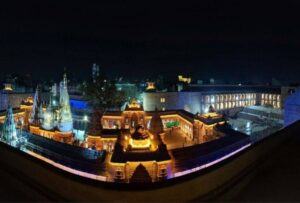
 According to Hindustan Times, The INR700 crore Kashi Vishwanath Corridor, which aims to transform the area around the centuries-old temple in Varanasi with state-of-the-art buildings and provide a clear access to the Ganga has been inaugrated by the PM recently.
According to Hindustan Times, The INR700 crore Kashi Vishwanath Corridor, which aims to transform the area around the centuries-old temple in Varanasi with state-of-the-art buildings and provide a clear access to the Ganga has been inaugrated by the PM recently.
The mega facelift project built across 550,000 sq. ft comprises 24 buildings that include an emporium, a museum, a sacred kitchen, a Vedic library, a centre to store ancient scriptures, a city gallery, and a food court – all built around the temple that serves as one of the nerve centres of the Hindu faith, attracting seven million pilgrims annually.
The showpiece of the project is restoration of the link between the Ganga and the temple, an ancient connection that had been cut off by years of encroachment, construction and population, said officials responsible for the corridor and its architects. Once open, the corridor will enable a pilgrim to take a boat from any of Varanasi’s numerous ghats to the sprawling new entrance to the temple complex built at the confluence of the Lalita Ghat and Jalasen Ghat.
The project’s architect, Bimal Patel, said Modi wanted the corridor to enable devotees to walk directly to the temple after collecting water from the Ganga.
“The corridor should be a link between the Ganga and the temple. We worked to restore the grandeur of the temple premises as per the vision of PM Modi,” said Patel.
“The original structure of the Kashi Vishwanath temple has not been tampered with; it has been allowed to remain as it is. The corridor has increased the facilities for the tourists and beautified the temple premises,” said Patel.
Modi laid the foundation of the corridor on March 8, 2019. In December 2019, Gujarat-based PSP Projectswas awarded the contract. Adityanath monitored the progress of the project, and inspected the corridor around 50 times in the past two years, said an official, who requested anonymity. The pandemic forced the work to halt twice in 2020 and 2021, but a fleet of 1,200 workers, mostly from West Bengal, worked round-the-clock once the second wave of Covid-19 abated.
“There are 24 buildings in the corridor. All buildings have been constructed and beautified. These are being decorated with special lights for the programme,” said SKVSADB chief executive officer Sunil Verma. A special sky beam light system has been installed in the corridor, to be visible from around 2km away, SKVSADB public relation officer Piyush Tiwari said.
A particular challenge before the architects and officials was manoeuvring the revamp project in an area where thousands of people lived in cheek-by-jowl homes, often jostling with overflowing drains and cows in cramped, centuries-old lanes. Despite the historical significance of the spot, workers found that many buildings were derelict, civic amenities were inadequate and encroachment rampant.
Earlier, the temple complex was surrounded by buildings on three sides and there was only one large gate for visitors on the south side of the complex. Now, the adjoining buildings and encroachments have been removed, and seven gates have been built with chunar stones, including a majestic gate opening up to the ghat.
“One of these grand gates is at the ghat in order that the devotees may reach Kashi Vishwanath Dham by boat as well,” said Verma.
During the construction, workers often found bits and pieces of faith entwined in homes and commercial establishments – small temples or idols installed by unknown people over the decades. Many of these temples were preserved and will be shown in the main gallery of the complex, said officials.
“The corridor will give glimpses of the sculptural art and architectural history of temples over 300 years because the 41 temples, which were found among the buildings purchased and demolished, have been preserved,” said Atul Tripathi, head of the history department at Banaras Hindu University.

Leave a Reply